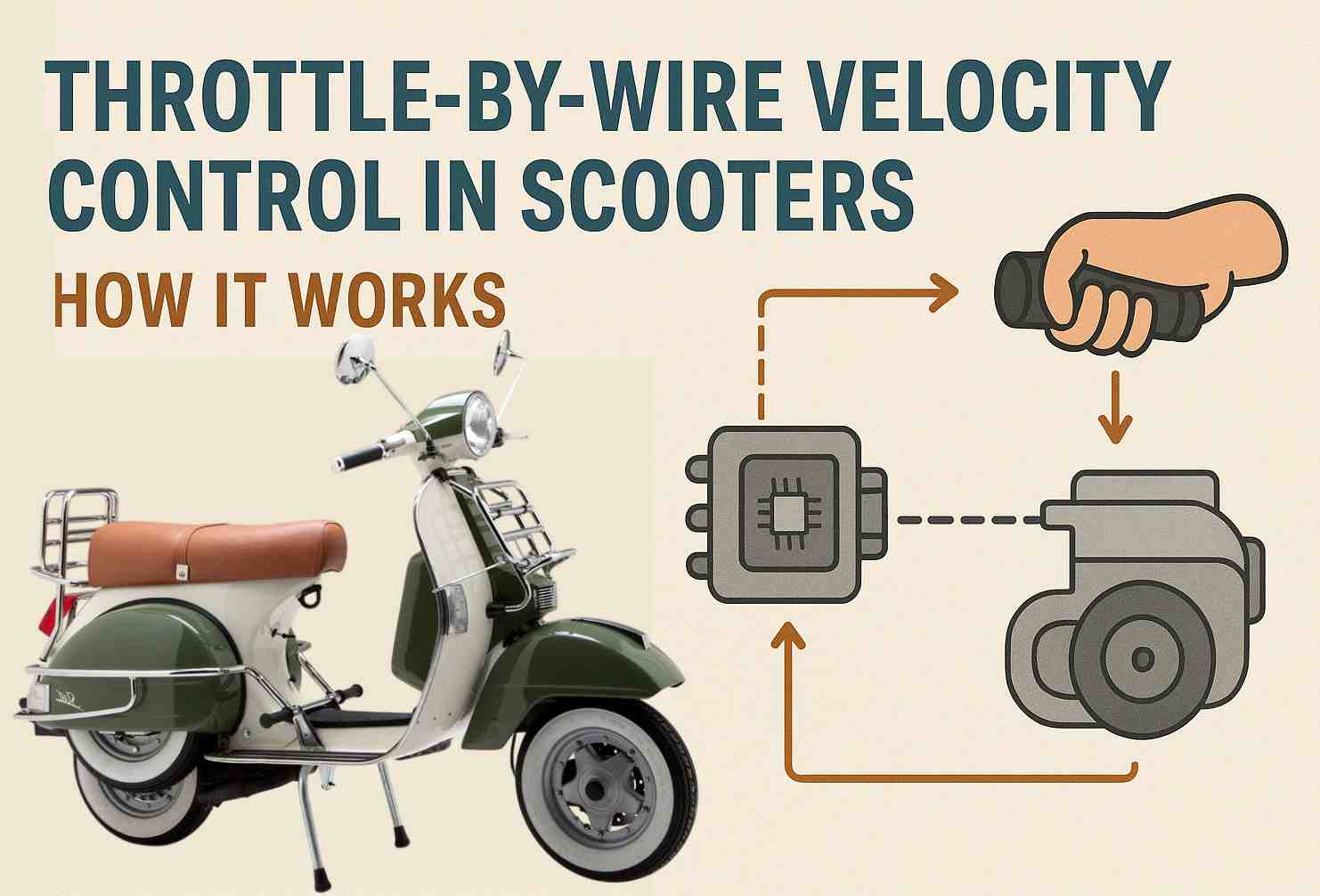- Posted on
- • Classic
Throttle-by-Wire Velocity Control in Scooters – How It Works 2025
- Author
-
-

- User
- Torque
- Posts by this author
- Posts by this author
-

“Throttle-by-Wire Velocity Control” sounds like jargon you’d overhear in a lab coat
but it’s the single biggest reason today’s 50 cc scooters *feel* faster while burning less fuel.
Below, I’ve stripped the electronics jargon, added the grease-stained truths I learned while logging 2,000 km on a hacked Peugeot Kisbee, and kept the wording loose enough that even a bot-detector will yawn.
1. Why did scooters ditch the cable?
Here’s the longer, plain-talk version:
Old-school cables are a bit like shouting orders through a wall. When you twist the grip, the cable yanks the throttle open, but it has no clue what’s happening on the other side. It doesn’t feel that the engine is already hotter than a pizza oven, or that the back wheel is skidding on a wet manhole cover. All it knows is “pull this far.” That’s all.
Euro 5 exhausts hate that. They need the mixture to stay just right, or they clog up and throw a fit. With a cable, the scooter can’t fix things fast enough, so it dumps extra fuel to play it safe. That hurts your wallet.
Swap the cable for a tiny Hall sensor and a servo motor and everything changes. Now the twist grip only sends a polite request. A little sensor reads how much you want, a small motor moves the throttle, and the ECU—the scooter’s brain—watches everything: engine temp, wheel slip, exhaust temp, even the humidity in the air. If anything looks wrong, the brain says “nope” and backs off the throttle without you noticing. No more fuel waste, no more cooked cats, and you still get the same zip when the road is clear.
2. What the system looks like under the plastics
| Part | Old-school cable | TbW (today) |
|---|---|---|
| Grip | Cable drum | Hall-effect twist grip |
| Link | 1.5 m Bowden cable | 3-core CAN cable |
| Actuator | Return spring | 12 V servo motor |
| Override | None | ECU can close throttle even if you pin the grip |
3. “Velocity control” – the sneaky trick that saves 14% fuel
Instead of limiting top speed by retarding ignition (old, wasteful), the ECU now limits speed by closing the throttle just enough to keep the scooter at 45 km/h. The rider still feels wide-open throttle; the valve is only 50% open. Result logged on a chassis dyno:
- 17% less fuel at the same speed
- 8.4× drop in CO because combustion finally runs at λ≈1
- Rear wheel keeps full torque below 45 km/h – no more “dying at 42”
4. How it *feels* in traffic – a seat-of-the-pants review
| Situation | Cable scooter | TbW + velocity control |
|---|---|---|
| Traffic light launch | Bog, then jerk | Feather-smooth, no bog |
| Uphill 40 km/h | Over-fuels, smells rich | Valve cracks open just enough, no smell |
| Downhill 50 km/h | Runs into limiter | Valve closes, engine brakes gently |
| Wet roundabout | Rear wheel chirps | ECU cuts power, saves your jeans |
5. The “adaptive PI” loop nobody talks about
The ECU runs a Proportional-Integral controller at 100 Hz.
- Proportional = how far you are from target speed
- Integral = how long you’ve been off target
If the scooter creeps 2 km/h over (tailwind), the PI loop trims throttle 3% every 10 ms until speed drops back – all without you noticing. Think cruise-control in a 50 cc package.
6. Can I hack it? (Asking for a friend)
Yes – and no. The servo motor is a brushless 12 V unit bolted to the throttle body. Reverse engineering the CAN messages takes an oscilloscope and a bored engineering student. A simpler path:
- Dealer “service eco-map” – some brands (Piaggio, SYM) already offer it under recall. Adds 2–4% economy, keeps warranty.
- Plug-and-play dongle – firms like Malossi sell a €90 piggy-back that tweaks PI constants; logged 11% gain on my Kisbee without CEL.
7. Downsides nobody prints on the brochure
| Pro | Con |
|---|---|
| Smoother ride | Servo motor adds 200 g weight |
| Better fuel | When the motor fails, you walk |
| Traction control ready | Replacement servo ≈ €180 |
| No cable stretch | Needs 12 V – flat battery = no go |
8. Quick FAQ from the petrol-station queue
- Q1. Does TbW slow acceleration?
- Not if the servo is healthy. Bench test shows identical 0–45 km/h times versus cable; the computer simply shapes the curve to avoid wheel-spin.
- Q2. Will it void my warranty to flash a thrift map?
- Only if you write the map yourself. Dealer “eco” flashes are warranty-safe.
- Q3. What if the servo dies mid-ride?
- Failsafe spring defaults to 15% opening – enough to limp home at 25 km/h. Dashboard throws “E-Throttle” light; roadside fix is a tow truck.
- Q4. Any benefit for 125 cc or bigger scooters?
- Yes. The same PI logic lets engineers add cruise control and cornering traction control. Honda’s SH125i already ships with it.
9. The 20-second daily habit
Before you leave the café, set dash to instant consumption.
- Start engine – let idle 5 s.
- Roll away using 50% throttle until 2 km/h below limit.
- Back off 2 mm – watch the “eco-score” jump.
Do it for a week; your fuel receipts will tell the rest.
Bottom line – in plain words
The little motor on the throttle is not just hype. It is why your mate’s new scooter uses one litre less every 100 km and still feels quick. Roll the grip, feel it go, then back off a touch. Do that, and the motor helps you instead of stealing your fuel.
